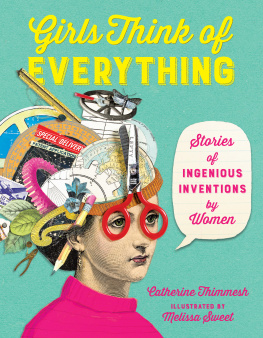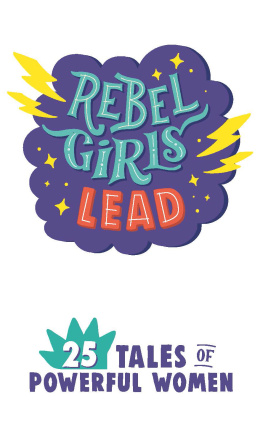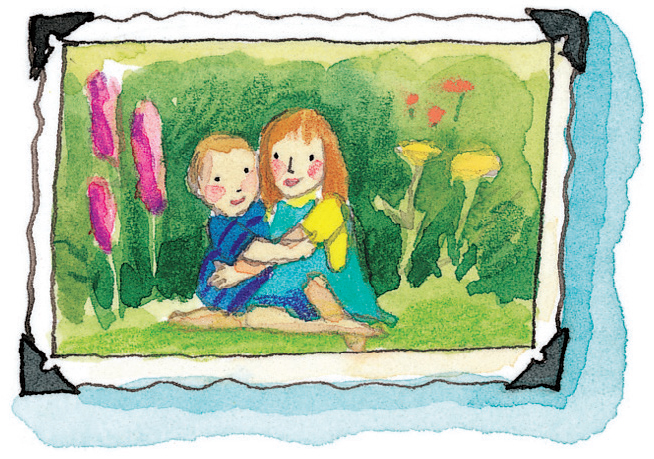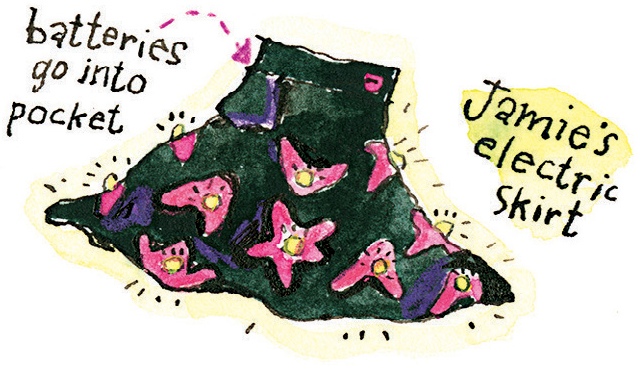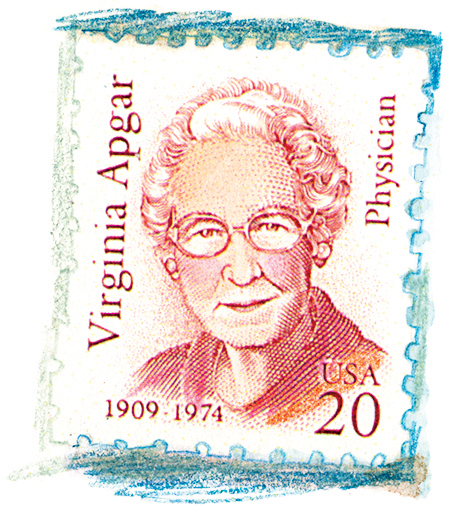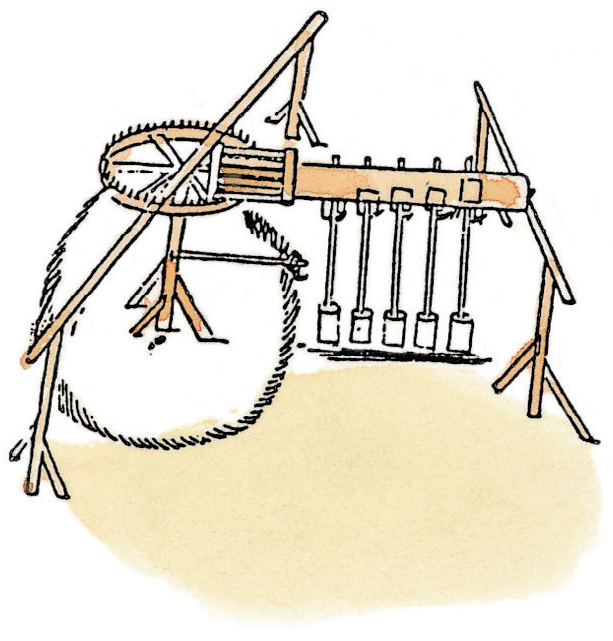Text copyright 2000 and 2018 by Catherine Thimmesh
Illustrations copyright 2000 and 2018 by Melissa Sweet
All rights reserved. For information about permission to reproduce selections from this book, write to or to Permissions, Houghton Mifflin Harcourt Publishing Company, 3 Park Avenue, 19th Floor, New York, New York 10016.
hmhco.com
Kevlar is a registered trademark of Du Pont.
Scotchgard is a trademark of 3M.
Snugli is a registered trademark of Snugli, Incorporated.
LuminAID is a registered trademark of LuminAID.
Roominate is a registered trademark of Roominate, LLC.
The illustrations are mixed media.
Collages photographed by Hugh Brantner Photography
Cover design by Whitney Leader-Picone
The Library of Congress has cataloged the hardcover edition as follows:
Thimmesh, Catherine.
Girls think of everything: stories of ingenious inventions by women / by Catherine Thimmesh; illustrated by Melissa Sweet.
p. cm.
Summary: Tells the story of how women throughout the ages have responded to situations confronting them in daily life by inventing such items as solar lanterns, baby carriers, and space bumpers.
RNF ISBN 0-395-93744-2 PAP ISBN 0-618-19563-7.
1. Women inventorsUnited StatesBiographyJuvenile literature. 2. InventionsUnited StatesHistoryJuvenile literature. [1. Inventors. 2. Inventions. 3. Women Biography.] I. Sweet, Melissa, ill. II.
Title
T39.T48 2000
609.2273dc2I [B] 99-36270 CIP
ISBN 978-1-328-77253-4 paper over board
eISBN 978-0-547-35052-3
v1.0918
For Jaimie and Simon, who invent new ways to amuse me every day
C.T.
In memory of Jamien Morehouse, who invented many wonderful things
M.S.
In the beginning...
With a push you are freebursting into the world scrunched up and screaming. Its a girl! the doctor announces. Or Its a boy! And so your life began. And with those very first breaths, and in those very first moments, your health and well-being were evaluated through the eyes of an ingenious inventor: Dr. Virginia Apgar. Dr. Apgar developed the Newborn Scoring Systemor Apgar scoreto measure five crucial aspects of a babys health: color, pulse, reflexes, activity, and respiration. She recognized the urgency of identifying those newborns in need of emergency attention, and because of her innovation, hundreds of thousands of lives have been saved. Today, all medical professionals evaluate a new baby using the Apgar Score within minutes of birth. Right from the get-go, a womans inventiveness and ingenuity touched your life. But that was only the beginning.
Whether in medicine or science, household products or high-tech gadgets, women and girls inventand their inventions surround us and affect our everyday lives. They have created cancer-fighting drugs, space bumpers, coffeemakers, and sleeping-bag coats to warm the homeless. Women have invented games and toys and computer soft-ware programs.
At first people refuse to believe that a strange new thing can be done, then they begin to hope it can be done, then they see it can be donethen it is done and all the world wonders why it was not done centuries ago.
Frances Hodgson Burnett, author of The Secret Garden
Inventors create for a variety of reasons. Maybe youve heard the saying Necessity is the mother of invention? Its true. An inventor sees a need and seeks to fill it. A long time ago, before there were record keepers or materials to keep records on, people went about their daily lives. And in doing so, they invented. According to oral tradition, as well as observations and studies conducted by anthropologists, women were responsible for some of the most fundamental and enduring innovations of all time. Because of their responsibilities within their families and communities, it appears that women were the first to invent tools and utensilsincluding the mortar (a heavy bowl) and pestle (a clublike hammer) to prepare food, such as flour, and botanical medicines.
They spun cotton together with flax, thereby inventing cloth. And they created the first shelters by designing and constructing huts and wigwams. It is said that women were the first to discover dyes to color cloth and tanning methods to make leather goods.
Throughout history, women have always been innovators. But their accomplishments have often been downplayed, skimmed over, or ignored altogether. In the year 1715, we have the first documented evidence of an invention by an American woman. Sybilla Masters invented a power-driven method for cleaning and curing corn based on her observations of Native American women using heavy pestles to pound the corn by hand.
Unfortunately, at that time, women were not allowed patents in their own names. In fact, women did not legally own any property whatsoever and were themselves considered to be the property of their husbands. So, for Sybilla to protect her invention, she had to settle for obtaining the patent in the name of her husband, Thomas Masters.
Nearly one hundred years would pass before an American womans invention would legally be recognized as her own. Mary Dixon Kies has the honor of holding the first U.S. patent ever awarded to a woman in her own name. Mary created an innovative process of weaving straw with silk or thread, primarily for use in ladies bonnets. She was awarded a patent in 1809, just as straw bonnets were becoming extremely fashionable.
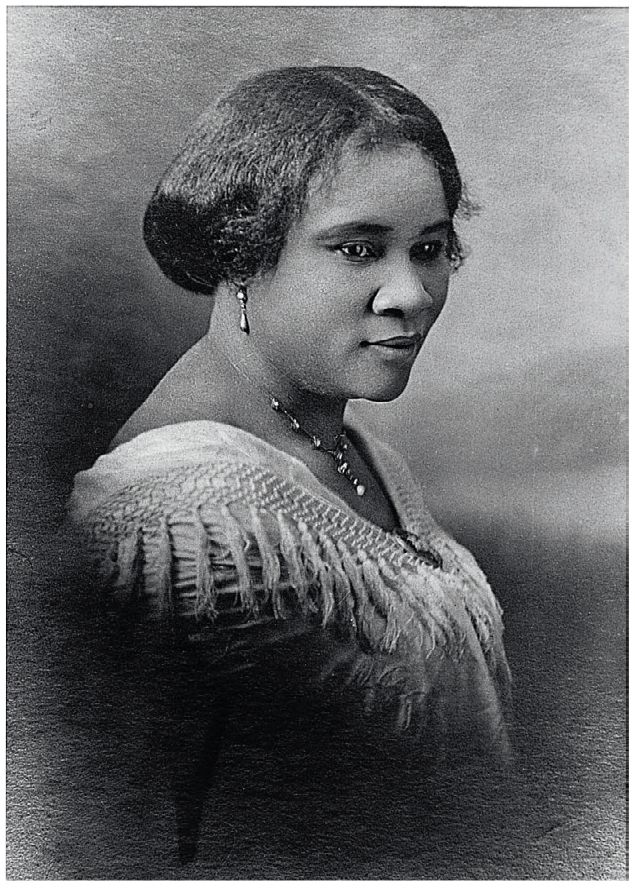
Against the odds, women have invented. They succeeded when many thought theyd fail. Madam C. J. Walker, the daughter of former slaves, invented hair-care products for African American women and a new method for selling them. She was born Sarah Breedlove, was orphaned at the age of seven, married at fourteen, and widowed at twenty. For nearly twenty years she labored doing other peoples laundry. Madam Walker began her business with a single product, a lot of confidence, and a dollar fifty. She went door-to-door giving free demonstrations and showing before-and-after photos of herself. Within seven years, she had several hair-care products and a thriving business. Madam C. J. Walker went on to become the first American woman self-made millionaire.
Many inventions evolve out of general curiositya sense of interest, a sense of Wouldnt it be fun if... ? And nothing says fun quite like a superhero arm... that shoots sparkly glitter. When she was just ten years old and away at camp, Jordan Reeveswho was born without her left forearmused a 3D printer to invent her own unique prosthetic arm that shoots a blast of shiny sparkles. Because, why not? You can never be sad with sparkles, she says.
These days, door-to-door demonstrations have been replaced with website tutorials and Internet crowdfunding campaigns and reality television shows. One-to-one salesmanship has given way to one-to-millions-of-viewers-at-a-time pitch fests. Lori Greiner, like Madam Walker, began with a single producta jewelry organizerwhich she was able to pitch on TV (on the QVC home shopping network) and quickly went on to sell half a million organizers. And that was only the beginning. Lori has since amassed more than 120 patents of her own, a business empire, and has helped other inventorsespecially other womensuccessfully launch more than 450 different products!

